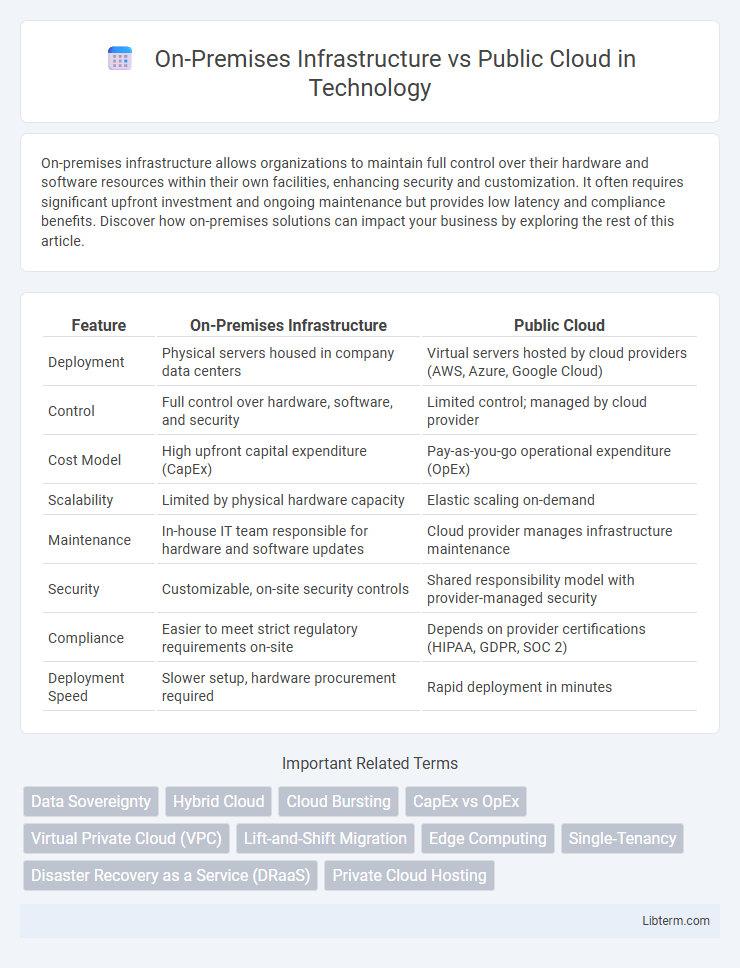On-premises infrastructure allows organizations to maintain full control over their hardware and software resources within their own facilities, enhancing security and customization. It often requires significant upfront investment and ongoing maintenance but provides low latency and compliance benefits. Discover how on-premises solutions can impact your business by exploring the rest of this article.
Table of Comparison
| Feature | On-Premises Infrastructure | Public Cloud |
|---|---|---|
| Deployment | Physical servers housed in company data centers | Virtual servers hosted by cloud providers (AWS, Azure, Google Cloud) |
| Control | Full control over hardware, software, and security | Limited control; managed by cloud provider |
| Cost Model | High upfront capital expenditure (CapEx) | Pay-as-you-go operational expenditure (OpEx) |
| Scalability | Limited by physical hardware capacity | Elastic scaling on-demand |
| Maintenance | In-house IT team responsible for hardware and software updates | Cloud provider manages infrastructure maintenance |
| Security | Customizable, on-site security controls | Shared responsibility model with provider-managed security |
| Compliance | Easier to meet strict regulatory requirements on-site | Depends on provider certifications (HIPAA, GDPR, SOC 2) |
| Deployment Speed | Slower setup, hardware procurement required | Rapid deployment in minutes |
Introduction to On-Premises Infrastructure and Public Cloud
On-premises infrastructure involves hosting and managing servers, storage, and networking hardware within an organization's physical location, providing direct control over data security and system configurations. Public cloud platforms such as Amazon Web Services (AWS), Microsoft Azure, and Google Cloud offer scalable computing resources delivered over the internet, eliminating the need for upfront hardware investments. Choosing between these environments depends on factors like compliance requirements, budget constraints, and the need for flexibility in resource provisioning.
Key Differences Between On-Premises and Public Cloud
On-premises infrastructure requires organizations to manage and maintain physical servers and networking hardware within their own data centers, offering complete control over security and compliance. Public cloud services deliver scalable computing resources through providers like AWS, Microsoft Azure, and Google Cloud, enabling rapid deployment and cost-efficiency by eliminating the need for upfront hardware investment. Key differences include capital expenditure versus operational expenditure models, customization capabilities, and varying levels of accessibility and disaster recovery features.
Cost Comparison: On-Premises vs Public Cloud
On-premises infrastructure requires significant upfront capital expenditure for hardware, software, and maintenance, whereas public cloud operates on a pay-as-you-go model with variable operational expenses. Total cost of ownership (TCO) for on-premises can be higher due to ongoing costs like power, cooling, and IT staff, whereas public cloud lowers these expenses but may incur unpredictable costs with scaling. Cost efficiency depends heavily on workload patterns, with steady, predictable usage often favoring on-premises, while fluctuating or spiky demands align better with public cloud economics.
Security Considerations in Both Environments
On-premises infrastructure offers organizations full control over security protocols, physical access, and data governance, enabling tailored protection against internal and external threats. Public cloud providers implement advanced security measures, including encryption, identity management, and continuous monitoring, but shared responsibility models require organizations to actively manage configuration and access controls. Evaluating compliance requirements, threat landscape, and resource capabilities is essential for optimizing security posture in both environments.
Scalability and Flexibility of On-Premises vs Public Cloud
On-premises infrastructure offers limited scalability as hardware upgrades require significant time and capital investment, restricting flexibility during demand spikes. Public cloud provides virtually unlimited scalability with instant resource allocation and pay-as-you-go models, enabling businesses to rapidly adjust to changing workloads. Flexibility in public cloud environments surpasses on-premises setups by supporting diverse applications through automated provisioning and global access.
Deployment and Maintenance Requirements
On-premises infrastructure requires substantial initial capital investment for hardware procurement, installation, and continuous maintenance by in-house IT teams, ensuring full control over deployment configurations and security protocols. Public cloud services offer rapid deployment through scalable, pay-as-you-go models without physical hardware management, reducing the need for dedicated maintenance personnel as cloud providers handle updates and infrastructure health. Organizations must evaluate operational costs, compliance requirements, and technical expertise when choosing between self-managed on-premises setups and outsourced cloud environments.
Performance and Reliability Factors
On-premises infrastructure offers direct control over hardware and network resources, enabling consistent low-latency performance critical for latency-sensitive applications. Public cloud platforms like AWS, Azure, and Google Cloud provide scalable performance with built-in redundancy and geographically distributed data centers, enhancing reliability through failover and disaster recovery capabilities. However, on-premises setups may deliver superior deterministic performance, while public cloud environments excel in elasticity and uptime SLAs exceeding 99.9%.
Compliance and Regulatory Implications
On-premises infrastructure enables organizations to maintain direct control over data storage and security, facilitating adherence to stringent compliance standards such as GDPR, HIPAA, and PCI DSS. Public cloud providers offer compliance certifications but may present challenges in data sovereignty and audit transparency due to shared environments and multi-tenant architectures. Choosing between on-premises and public cloud requires evaluating regulatory requirements, data residency mandates, and the provider's compliance attestations to ensure full regulatory alignment.
Use Cases: When to Choose On-Premises or Public Cloud
On-premises infrastructure is ideal for organizations requiring high data security, low latency, and full control over hardware, commonly seen in financial institutions and healthcare providers. Public cloud suits businesses needing scalable resources, rapid deployment, and cost flexibility, such as startups, e-commerce, and global SaaS companies. Hybrid models often emerge when firms require both local data processing and cloud scalability for diverse application demands.
Future Trends in IT Infrastructure Management
Future trends in IT infrastructure management emphasize hybrid and multi-cloud strategies that integrate on-premises infrastructure with public cloud services to enhance flexibility, scalability, and cost efficiency. Increasing adoption of edge computing and AI-driven automation is expected to optimize resource allocation and improve real-time data processing across environments. Security innovations such as zero-trust architecture are fundamental to managing the complexities and risks in mixed IT infrastructures.
On-Premises Infrastructure Infographic

 libterm.com
libterm.com